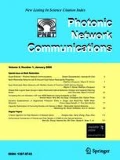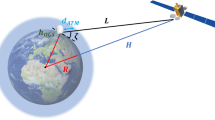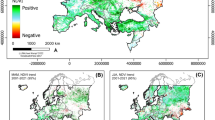Abstract
Ultraviolet and mid-infrared (MIR) constitute two extreme ends of the optical wireless communication band. Recently, there has been a rise in increased interest for research in these two spectral bands. For successful deployment of these technologies, the performance of these two spectrum bands needs to be thoroughly analyzed. We consider turbulence and noise effects over these spectral bands. Specifically, this paper considers separate and combined effects of atmospheric turbulence and various noise sources to model the channel impairment. The results show that the system performances are extremely sensitive to the choice of channel model. It is found that the relatively unused MIR spectrum offers excellent characteristics for outdoor optical communications in the presence of atmospheric turbulence.







Similar content being viewed by others
References
Andrews, L.C., Phillips, R.L.: Laser Beam Propagation Through Random Media, vol. 152. SPIE Press, Bellingham (2005)
Ghassemlooy, Z., Arnon, S., Uysal, M., Xu, Z., Cheng, J.: Emerging optical wireless communications-advances and challenges. IEEE J. Sel. Areas Commun. 33(9), 1738 (2015)
Mahdy, A., Deogun, J.S.: In: 2004 IEEE Wireless Communications and Networking Conference (IEEE Cat. No. 04TH8733), vol. 4, pp. 2399–2404. IEEE (2004)
Arya, S., Chung, Y.H.: Spectrum sensing for free space optical communications in strong atmospheric turbulence channel. Opt. Commun. 445, 24 (2019)
Liao, L., Li, Z., Lang, T., Chen, G.: UV LED array based NLOS UV turbulence channel modeling and experimental verification. Opt. Express 23(17), 21825 (2015)
Arya, S., Chung, Y.H.: Non-line-of-sight ultraviolet communication with receiver diversity in atmospheric turbulence. IEEE Photonics Technol. Lett. 30(10), 895 (2018)
Prasad, N.S.: Free-Space Laser Communications, pp. 347–391. Springer, Berlin (2005)
McClintock, R., Haddadi, A., Razeghi, M.: In: Quantum Sensing and Nanophotonic Devices IX, vol. 8268, p. 826810. International Society for Optics and Photonics (2012)
Kopeika, N.S., Bordogna, J.: Background noise in optical communication systems. Proc. IEEE 58(10), 1571 (1970)
Arnon, S.: Effects of atmospheric turbulence and building sway on optical wireless-communication systems. Opt. Lett. 28(2), 129 (2003)
Arya, S., Chung, Y.H.: A novel blind spectrum sensing technique for multi-user ultraviolet communications in atmospheric turbulence channel. IEEE Access 7, 58314 (2019)
Motlagh, A.C., Ahmadi, V., Ghassemlooy, Z., Abedi, K.: In: 2008 6th International Symposium on Communication Systems, Networks and Digital Signal Processing, pp. 540–543. IEEE (2008)
Xu, F., Khalighi, M.A., Bourennane, S., et al.: COST IC0802 Workshop. In: IEEE ConTEL Conference, pp. 211–218 (2011)
Wang, P., Qin, J., Guo, L., Yang, Y.: BER performance of FSO limited by shot and thermal noise over exponentiated Weibull fading channels. IEEE Photonics Technol. Lett. 28(3), 252 (2015)
Saxena, P., Mathur, A., Bhatnagar, M.R., Ghassemlooy, Z.: In: 2017 IEEE 28th Annual International Symposium on Personal, Indoor, and Mobile Radio Communications (PIMRC), pp. 1–6. IEEE (2017)
Ansari, I.S., Yilmaz, F., Alouini, M.S.: In: 2015 IEEE 81st Vehicular Technology Conference (VTC Spring), pp. 1–5. IEEE (2015)
Ninos, M.P., Nistazakis, H.E., Sandalidis, H.G., Stassinakis, A.N., Tombras, G.S.: Block error rate performance of OOK free-space optical links over gamma–gamma turbulence channels with generalised non-zero boresight pointing errors. IET Optoelectron. 12(6), 269 (2018)
Ansari, I.S., Yilmaz, F., Alouini, M.S.: Performance analysis of free-space optical links over Málaga turbulence channels with pointing errors. IEEE Trans. Wirel. Commun. 15(1), 91 (2015)
Wu, J., Li, Y.: In: ICMIT 2005: Information Systems and Signal Processing, vol. 6041, p. 60410Q. International Society for Optics and Photonics (2006)
Aung, T.Y., Arya, S., Chung, Y.H.: Performance dependence of non-line-of-sight ultraviolet communications on atmospheric parameters of the ultraviolet channel. Opt. Commun. 443, 7 (2019)
Ishimaru, A.: Wave Propagation and Scattering in Random Media, vol. 2. Academic Press, New York (1978)
Goodman, J.W.: Statistical Optics. Wiley, New York (2015)
Keiser, G.: Optical Communications Essentials (Telecommunications). McGraw-Hill, New York (2003)
Pratt, W.K.: Laser Communication Systems. John Wiley and Sons, Inc., New York (1969)
Arnon, S.: Pointing Error Statistics, pp. 87–89. Cambridge University Press, Cambridge (2012)
Acknowledgements
This research was supported by the Basic Science Research program through the National Research Foundation of Korea (NRF) funded by the Ministry of Education (2018R1D1A3B07049858).
Author information
Authors and Affiliations
Corresponding author
Additional information
Publisher's Note
Springer Nature remains neutral with regard to jurisdictional claims in published maps and institutional affiliations.
Rights and permissions
About this article
Cite this article
Biswal, M.R., Arya, S. & Chung, Y.H. Effect of turbulence and noise on ultraviolet and mid-infrared spectrum in optical wireless communications. Photon Netw Commun 39, 181–186 (2020). https://doi.org/10.1007/s11107-020-00882-z
Received:
Accepted:
Published:
Issue Date:
DOI: https://doi.org/10.1007/s11107-020-00882-z




